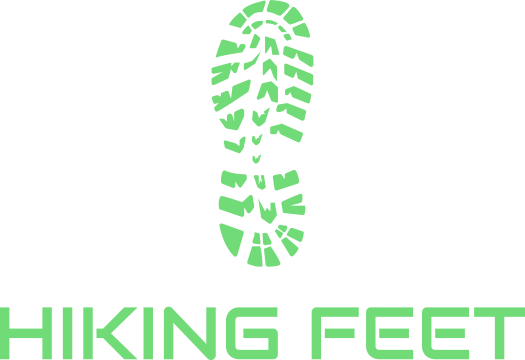Traction isn't the first thing I think about when I'm buying hiking shoes or hiking boots. But the right hiking boot soles can make a big difference—especially if you’re hiking mountains or slogging through snow, mud, or slippery scree slopes. That's why it pays to learn how to choose the right tread for your hikes. Are you having traction troubles? Have you been slipping on snow or scree? Do you need better downhill traction? Or better grip on rock? As the former footwear manager at a hiking and backpacking shop, I can help you figure out how to match hiking boot soles to the terrain you hike.
Some of the links in this post are affiliate links. If you click on an affiliate link and buy something, the retailer may share a small percentage of the sale with Hiking Feet. That's free for you—and gives you an easy way to support this site's free and independent content.
How to match tread to terrain
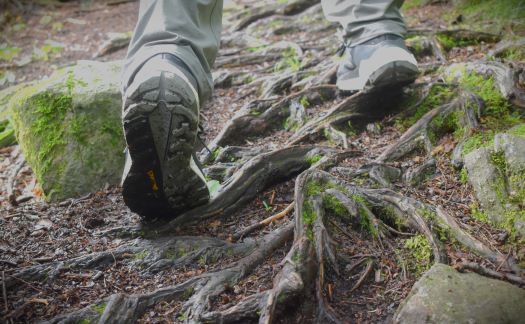
No single hiking shoe or hiking boot sole has the best overall traction. That's because different soles do better—and worse—on different types of terrain.
For example, my hiking boot soles have deep, aggressive lugs to dig into the ground on steep trails, but that tread leads to dodgy traction on rock. Similarly, the soft rubber soles that let me stick to slick rock like Spiderman will have me slipping and sliding in snow, scree, and mud.
The trick is matching traction to the terrain you hike. With a basic knowledge of hiking boot soles, you can choose the best tread for where you do most of your hiking. Here's how:
best hiking boot soles for steep terrain
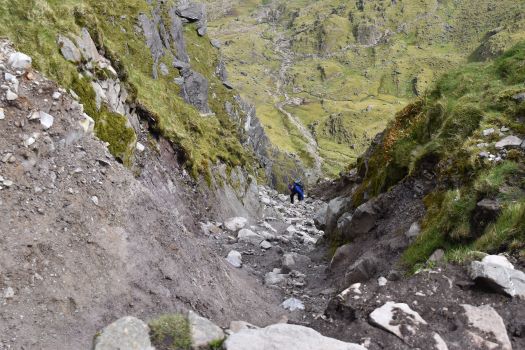
What are the best soles for steep hikes?
For steep hikes on soft or loose surfaces, hikers should choose hiking boot soles with deep lugs with well-defined edges to dig into dirt, mud, gravel, scree, and loose rock.
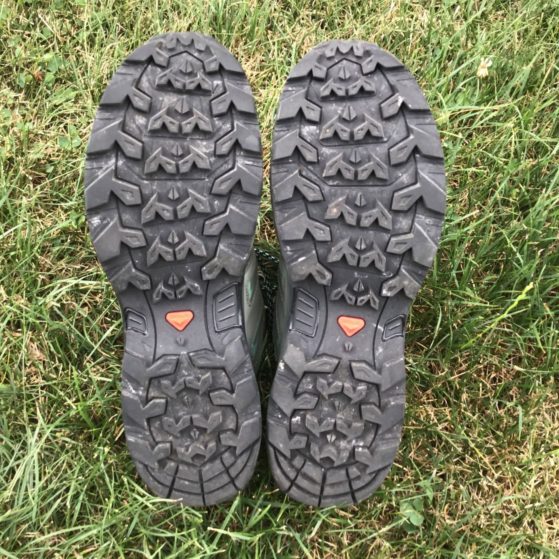
Salomon outsoles with climbing (top) and braking (bottom) lugs
Aggressive lugs
For the best bite on trails that are not solid rock, choose soles with V-shaped lugs and Z-shaped grooves and edges. On the right, the Salomon X Ultra 4 features Contragrip outsoles with aggressive, chevron-shaped climbing lugs (under the forefoot) and braking lugs (under the heel) for steep ascents and descents on scree, gravel, mud, or snow.

Deep heel brake on the Oboz Bridger hiking boot
Deep heel brakes
Hiking boot soles with a deep heel brake—a pronounced edge beneath the heel—dig into soft and shifting surfaces on steep descents, which is where most serious falls occur. On the Oboz Bridger (pictured on left), I can fit my two fattest fingers in front of the deep heel brake.
Hiking boot/shoe recommendations for steep trails: For moderate to difficult terrain, I love the aggressive climbing lugs and braking lugs in the Salomon X Ultra 4—both the lightweight hiking boot and low-cut hiking shoes. The Oboz Bridger and Lowa Renegade hiking boots both have deep heel brakes that lets me descend faster than many hikers on steep downhills. Among my trail running shoes, I like the relatively aggressive soles on the Brooks Cascadia, Salomon Thundercross, and Lowa Fortux for steeper trails with mud, scree, and snow.
best hiking boot soles for solid rock
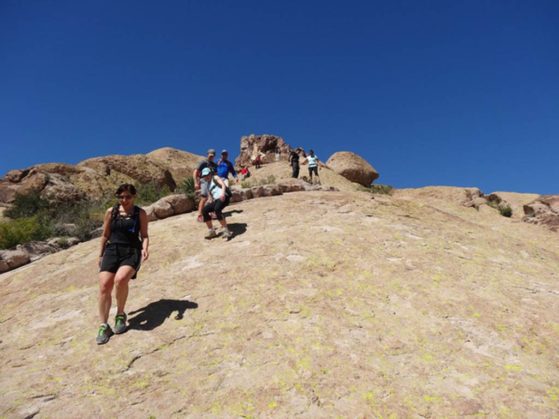
slickrock in Arizona's Superstition Wilderness
What soles provide the best rock traction?
For the best flat-rock and slick-rock traction, you need friction. That means choosing soft rubber soles and shallow lugs that maximize the surface area where the rubber can rub on rock to generate grip.
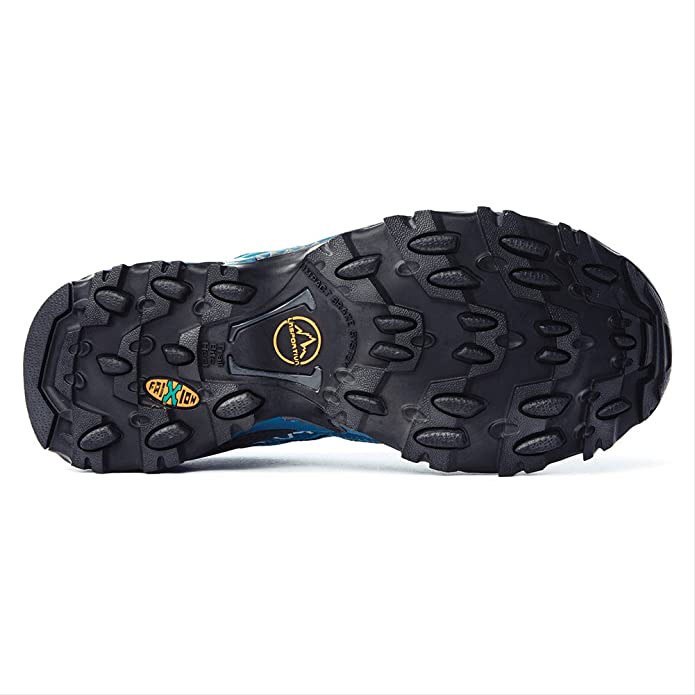
La Sportiva outsoles excel on rocky terrain
Shallow lugs
Shallow lugs with rounded edges keep as much of the sole as possible on solid rock to maximize grip for hiking.
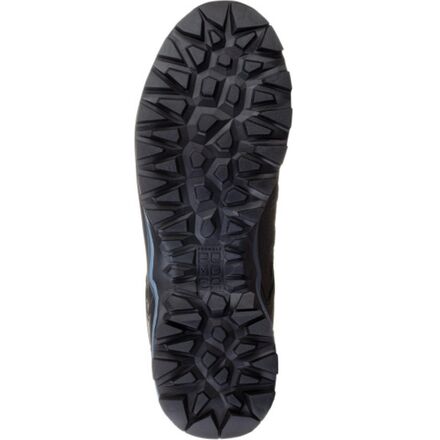
grippy Pomoca rubber outsoles on Salewa MTN Trainer Lite
Soft rubber
Soft rubber sticks to rocks better than harder rubber soles by increasing friction for stickier traction. Good examples include La Sportiva's Frixion rubber, several Vibram outsoles, and the Presa Super Gum rubber on several Scarpa hiking boots.
Soft rubber offers the best grip on rocks; however, it also wears down pretty quickly. So keep that in mind as you're comparing the rubber compounds on various hiking boots, hiking shoes, and trail runners. In general, you'll get the best rock traction from climbing shoe brands, such as Scarpa and La Sportiva.
Recommended hiking boots/shoes for rock traction: The best hiking shoes for slick rock include the Salewa Mountain Trainer Lite GTX and Scarpa Rush 2 GTX. Among hiking and backpacking boots, the La Sportiva Nucleo High II GTX, La Sportiva Ultra Raptor Mid, and Scarpa Zodiac Plus GTX feature some of the best hiking boot soles for solid rock. Trail runners with good rock traction include La Sportiva's Ultra Raptor II and the Hoka Speedgoat.
best hiking boot soles for wet rock
Realistically, you won't get perfect performance on wet rock from any hiking boot or hiking shoe outsole. That's especially true if there's wet algae or thin layers of film. However, you can improve your grip on wet rock and lower your risk for hard falls with these features:
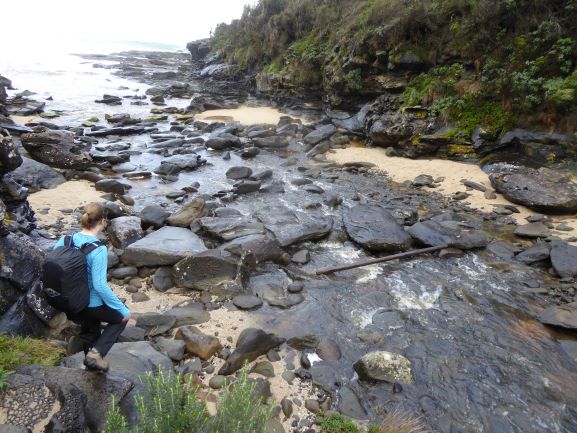
What's the best tread for wet rock?
Hiking boot soles with soft rubber with shallow tread maximizes the contact points for hiking boot and hiking shoe soles to smear against slick rock and flat rock. Some brands us specialized rubber known for both wet and dry traction, especially Vibram outsoles.
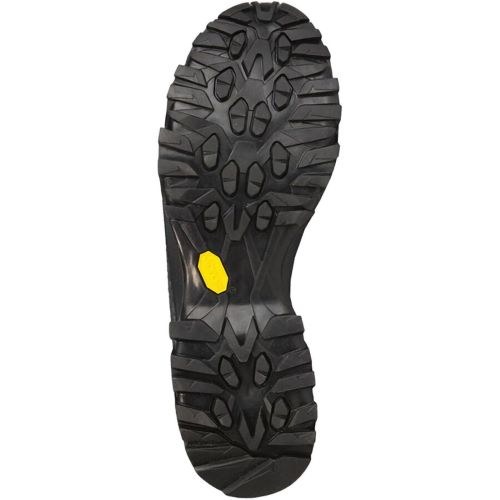
La Sportiva Nucleo High GTX soles
Soft and shallow lugs
The hardest soles can't dig into solid rock, so hikers should start with soft rubber outsoles with shallow lugs to maximize friction, which is what grips to solid rock.
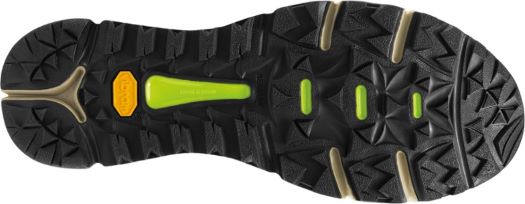
Danner sources many outsoles from Vibram
Vibram Megagrip rubber
Vibram Megagrip rubber is a rubber compound that excels on both wet and dry surfaces. If you go chasing waterfalls or wet mountain trails, look for hiking boot soles with Vibram Megagrip rubber for better traction.
best hiking boot soles for mud and snow
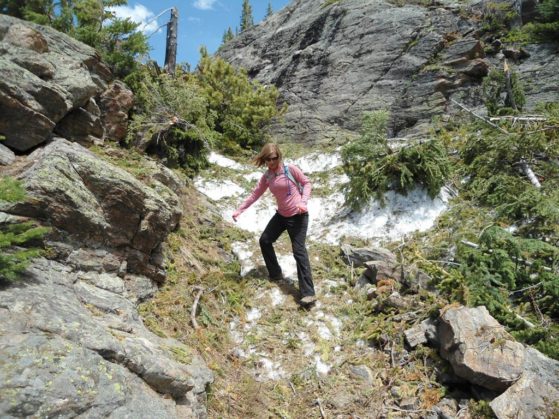
What's the best tread for mud or snow?
Hiking boot soles can't dig into solid rock, but they can dig into mud and snow. For the best traction on slick mud and snow, choose hiking boots with deep and widely spaced lugs to keep your boots or shoes as clean and grippy as possible.
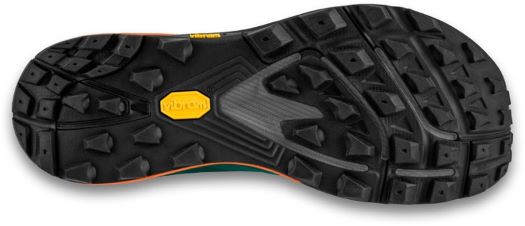
Vibram soles on Topo Athletic hiking shoes
Deep lugs
Deeper lugs can dig deeper into snow, mud, and soft surfaces, giving hikers more purchase on these slick surfaces. Look for more angular shaped lugs that are 5mm deep for better traction on soft ground.
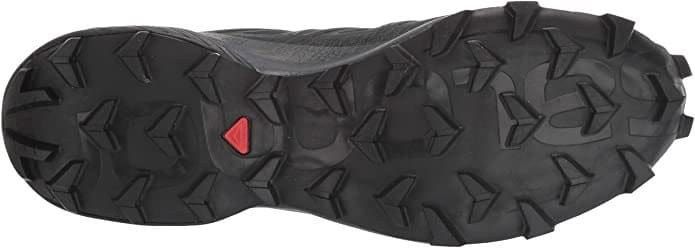
Salomon Speedcross soles with widely spaced lugs to shed mud
Widely spaced lugs
Wider spaces between the lugs on hiking boot soles make it tougher for mud, snow, and ice to cake up and compromise your traction on soft surfaces.
Recommended hiking boots/shoes for mud and snow: For muddy trails, I again like the Salomon X Ultra 4 hiking boots and shoes. The Salomon Speedcross stands out for some of the best mud traction among trail running shoes. I've also had good luck with the Vibram outsoles on the Topo Athletic Ultraventure Pro.
best hiking boot soles for mixed terrain

Hiking boot soles for moderate trails?
For moderate trails or multi-surface hiking, it's best to avoid extremes and stick to moderately deep lugs (for decent traction in mud and snow) and wide lugs with plenty of surface area (for more friction on rock).

classic Vibram all-purpose hiking soles
Moderately deep lugs
Hiking soles with wide, moderately spaced lugs balance tread on soft and loose surfaces with rock traction. The classic Vibram outsoles on the right are good on almost any trail without excelling on any type of terrain.
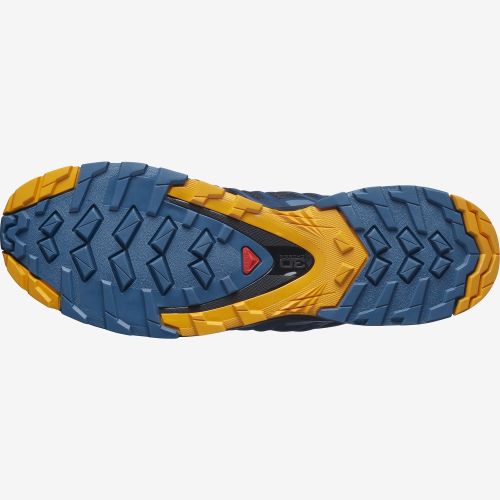
Salomon XA Pro trail runners for multi-surface traction
Multipurpose lugs
Look for a mix of lugs for hikes on moderate terrain.
For moderate, mixed terrain, I like the tread on the Oboz Sawtooth and KEEN Targhee hiking boots for day hiking and the hiking boot soles on the LOWA Renegade and Salomon Quest for backpacking. Among trail running shoes, the Salomon XA Pro has moderate tread for multisurface hiking.
Vibram outsoles
Many premium hiking boots and hiking shoes source their outsoles from Vibram—an Italian company that's been making high-end rubber soles since the 1930s. If you see Vibram outsoles on a pair of hiking boots, hiking shoes, or trail runners, that's generally a good thing.

Look for yellow Vibram logos on the soles of hiking boots like the Scarpa Zodiac
At the same time, keep in mind that Vibram makes a range of hiking boot soles for different terrains. For example, the Vibram TC5+ sole on the Merrell Moab is a multi-purpose sole that's fine for easier trails and everyday wear. But Vibram doesn't even classify that a "hiking" sole—that's their "work" tread, not "hiking" tread. (So it's not surprising that some my customers at Appalachian Outdoors complained about Merrells' traction on steep or muddy hiking trails.) Here's a quick mini-guide to Vibram rubber compounds used in some of the best hiking shoe and hiking boot soles:
- Vibram XS Trek outsoles feature a rubber compound that's known for flexible, multi-sport performance and wet traction.
- Vibram Mont is a durable rubber compound designed for mountaineering boots and hiking boots suited for low temperatures and difficult, Alpine terrain.
- Megagrip is Vibram's high-performance rubber compound that the company promotes for its unparalleled grip on wet and dry surfaces.
Also keep in mind that the size and shape of the lugs on Vibram outsoles leads to different performance profiles. My pro tips above will help you match your tread to the terrain you hike.
Accessories for better hiking traction
Matching tream to the terrain you hike goes a long way towards better hiking traction. However, more extreme conditions may require some added traction aids, such as micro-spikes or trekking poles.
Winter Traction Devices: In snowy and (especially) icy conditions, many hikers will slip on a pair of micro-spikes to wear on top of their hiking boot soles for added traction. For the safest, most reliable traction on snow or ice, hikers should stick to proven accessories, such as Kahtoola Microspikes or slip-ons that mimic Kahtoola's time-tested traction:
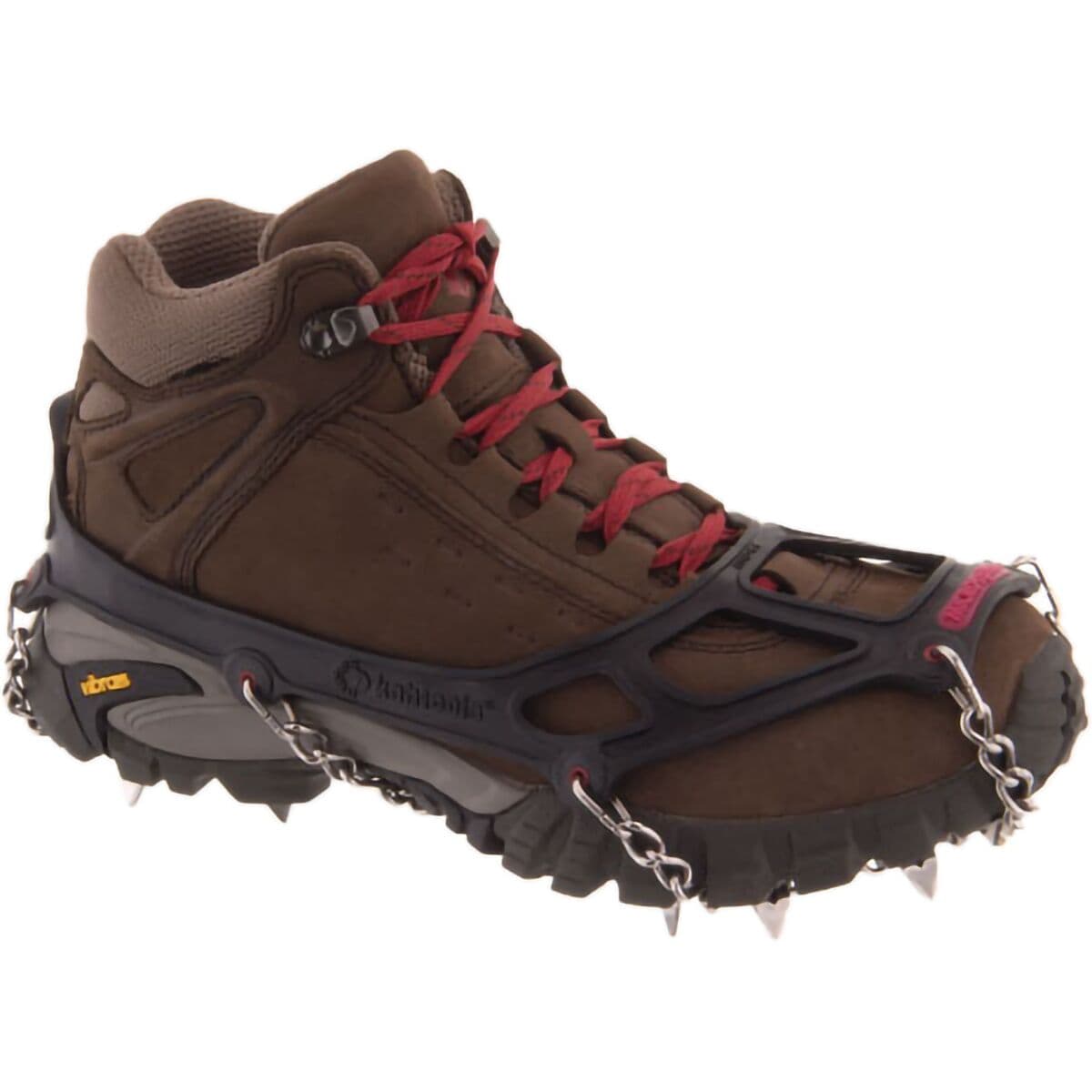


pro tip on winter traction devices
Yaktrax are good for snowy sidewalks, but not for hiking. It's worth paying a few more dollars for true Microspikes.
Trekking Poles: Another way to augment the traction of your hiking boot soles is to hike with trekking poles. Trekking poles not only save your knees on steep descents, but also improve your balance and traction on treacherous terrain, such as scree, snow, ice, mud, and water crossings.
For the best performance, I recommend Leki trekking poles or Black Diamond trekking poles for safer hikes when the footing gets tough:

buying hiking boot soles for you hiking style
This post should help you match the soles of your hiking boots, hiking shoes, or trail running shoes to the terrain you hike. If you're feeling smarter about hiking traction, please like and share this post, so other hikers can find it, too. Also, feel free to use the affiliate links above if this post steer you towards some footwear with good tread for your favorite trails. That's free and easy for you and does me a solid—I rely on those commissions to keep this site afloat and make a little from all the unpaid hours I've spend helping men and women buy hiking footwear that fits their feet and matches their hikes.
Thanks for your support, and happy hiking!
